ComfyUI
This tutorial is a community contribution and is not supported by the Open WebUI team. It serves only as a demonstration on how to customize Open WebUI for your specific use case. Want to contribute? Check out the contributing tutorial.
ComfyUI is a powerful and modular node-based GUI for Stable Diffusion. It gives users a high degree of control over the image generation process. Learn more or download it from its GitHub page.
To run ComfyUI and make it accessible to Open WebUI, you must start it with the --listen flag to bind to 0.0.0.0. This allows it to accept connections from other computers on your network.
Once running, the ComfyUI interface will be available at http://<your_comfyui_ip>:8188.

Connecting ComfyUI to Open WebUI
Since Open WebUI typically runs inside Docker, you must ensure the container can reach the host-based ComfyUI application via host.docker.internal.
-
Host Binding Check: Ensure ComfyUI is running with the
--listen 0.0.0.0flag (Step 5). -
Firewall Check: If the host firewall (UFW) is active, ensure port 8188 is allowed (
sudo ufw allow 8188/tcp). -
Docker Run Command (Linux Native Docker): For Linux users not running Docker Desktop, you must explicitly map the host gateway when running the Open WebUI container.
docker run -d -p 3000:8080 \
--add-host=host.docker.internal:host-gateway \
-e COMFYUI_BASE_URL=http://host.docker.internal:8188/ \
-e ENABLE_IMAGE_GENERATION=True \
-v open-webui:/app/backend/data \
--name open-webui \
--restart always \
ghcr.io/open-webui/open-webui:main
Once you have ComfyUI installed and running, you can connect it to Open WebUI from the admin settings.
Create Image (Image Generation)
-
Navigate to Image Settings: In Open WebUI, go to the Admin Panel > Settings > Images.
-
Enable and Configure ComfyUI:
- Ensure the Image Generation toggle at the top of the page is enabled.
- Under the Create Image section, set the Image Generation Engine to
ComfyUI. - Model: Select the base model to be used for generating the image.
- Image Size: Defines the resolution of the generated image (e.g., 512x512, 1024x1024).
- Steps: The number of sampling steps; higher values can improve image quality but take longer to process.
- Image Prompt Generation: When enabled, this feature uses a language model to automatically generate a more detailed and creative prompt based on your initial input, which can lead to better image results.
- In the ComfyUI Base URL field, enter the address of your running ComfyUI instance (e.g.,
http://host.docker.internal:8188/). - Click the refresh icon (🔄) next to the URL field to verify the connection. A success message should appear.
- If your ComfyUI instance requires an API key, enter it in the ComfyUI API Key field.
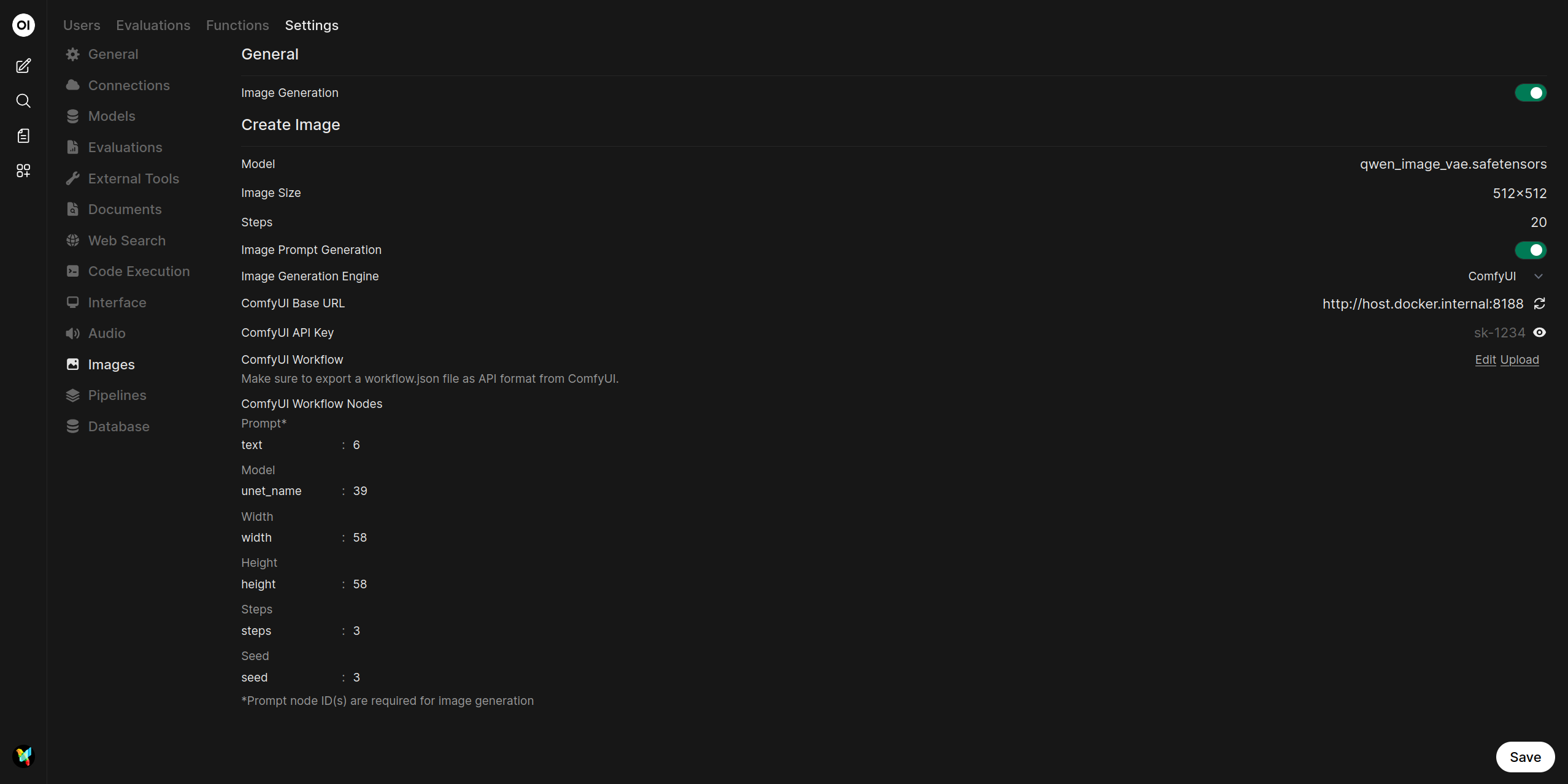
-
Upload Your ComfyUI Workflow:
- First, you need to export a workflow from ComfyUI in the correct format. In the ComfyUI interface, click the ComfyUI logo at the top left and click Settings. Then search for and toggle on the "Dev Mode" option with a description that states "Enable dev mode options (API save, etc.)".
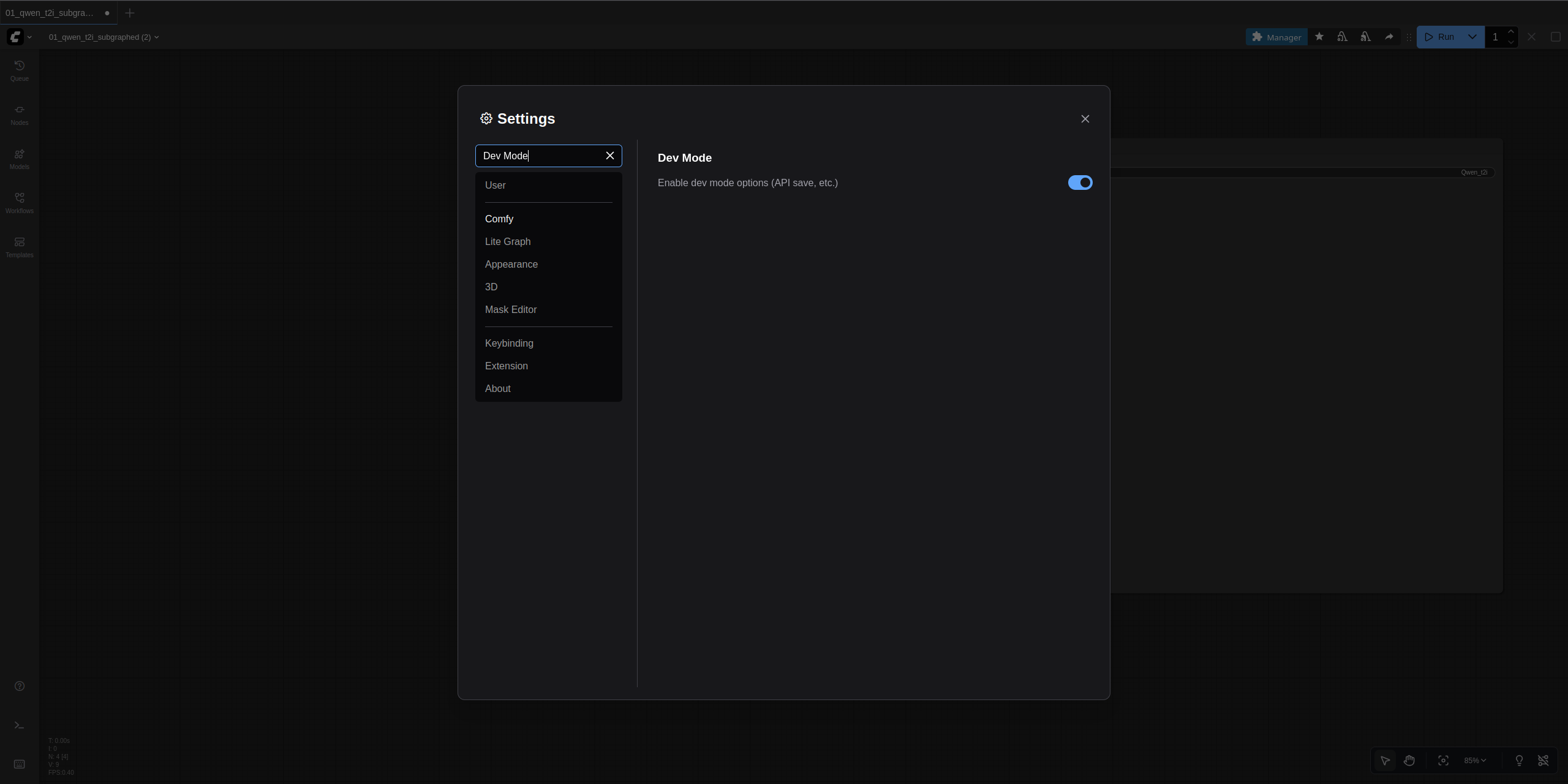
- While still in ComfyUI, load the image generation workflow you want to use, and then click the "Export (API)" button found in the File sub-menu after clicking on the ComfyUI logo. This will prompt you to name the file. Name it something memorable and download it.
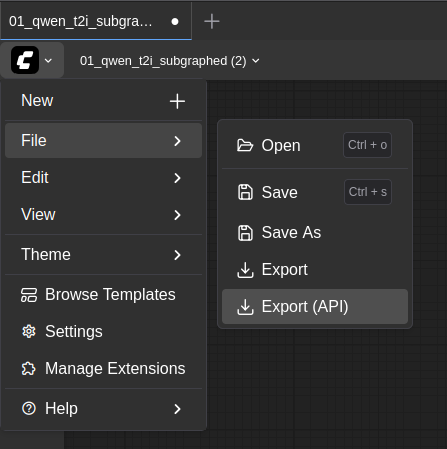
- Back in Open WebUI, under the ComfyUI Workflow section, click Upload. Select the JSON workflow file you just downloaded.
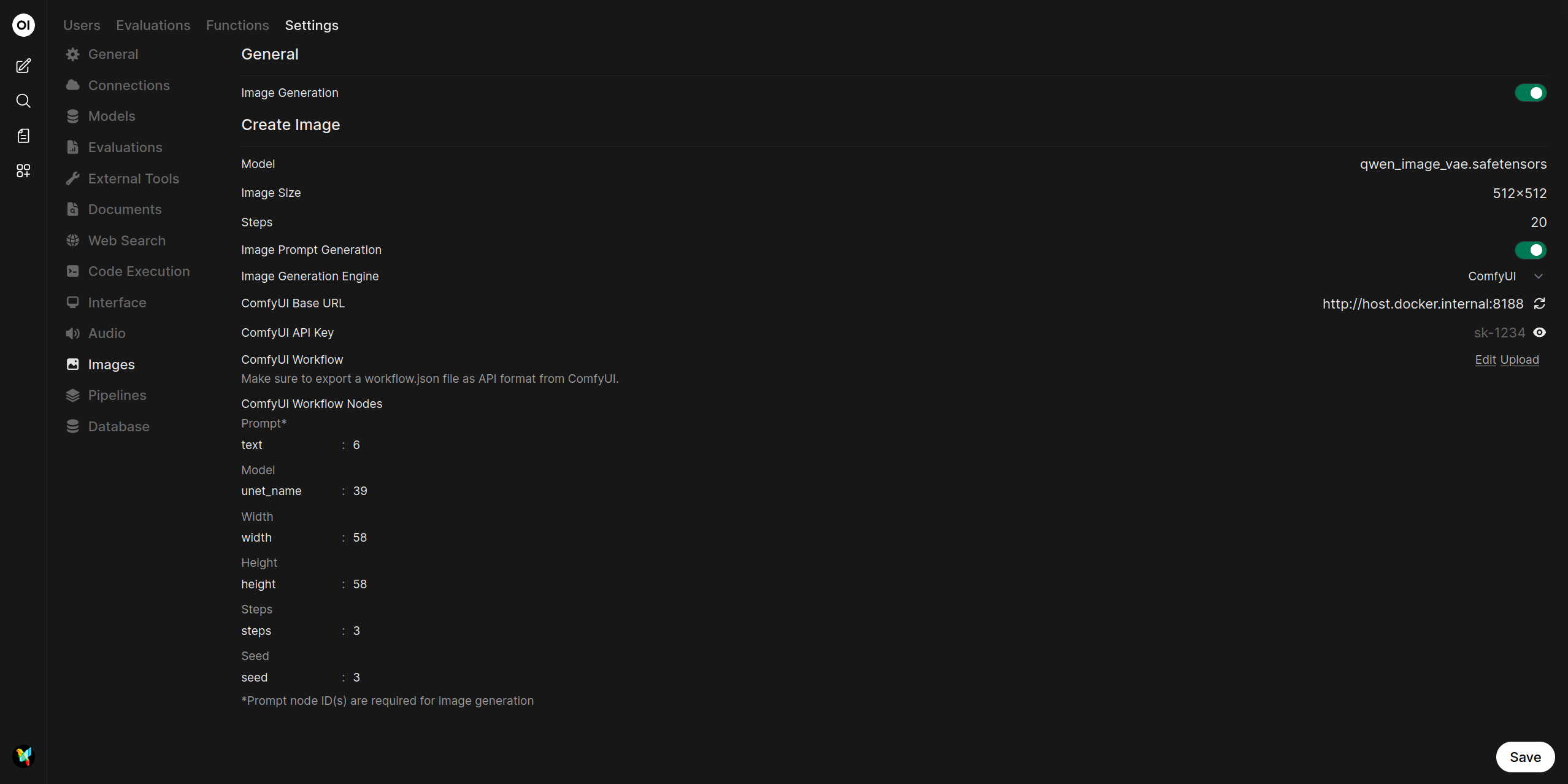
-
Map Workflow Nodes:
- After the workflow is imported, you must map the node IDs from your workflow to the corresponding fields in Open WebUI (e.g.,
Prompt,Model,Seed). This tells Open WebUI which inputs in your ComfyUI workflow to control. - You can find the node ID by clicking on a node in ComfyUI and viewing its details.
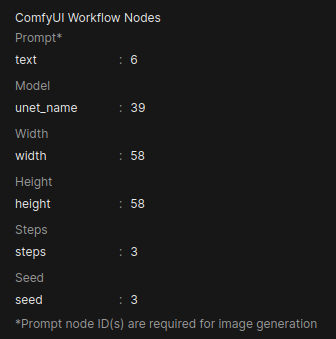 info
infoYou may need to adjust an
Input Keywithin Open WebUI'sComfyUI Workflow Nodessection to match a node in your workflow. For example, the defaultseedkey might need to be changed tonoise_seeddepending on your workflow's structure.tipSome workflows, such as ones that use any of the Flux models, may utilize multiple nodes IDs that is necessary to fill in for their node entry fields within Open WebUI. If a node entry field requires multiple IDs, the node IDs should be comma separated (e.g.,
1or1, 2). - After the workflow is imported, you must map the node IDs from your workflow to the corresponding fields in Open WebUI (e.g.,
-
Save Configuration:
- Click the Save button at the bottom of the page to finalize the configuration. You can now use ComfyUI for image generation in Open WebUI.
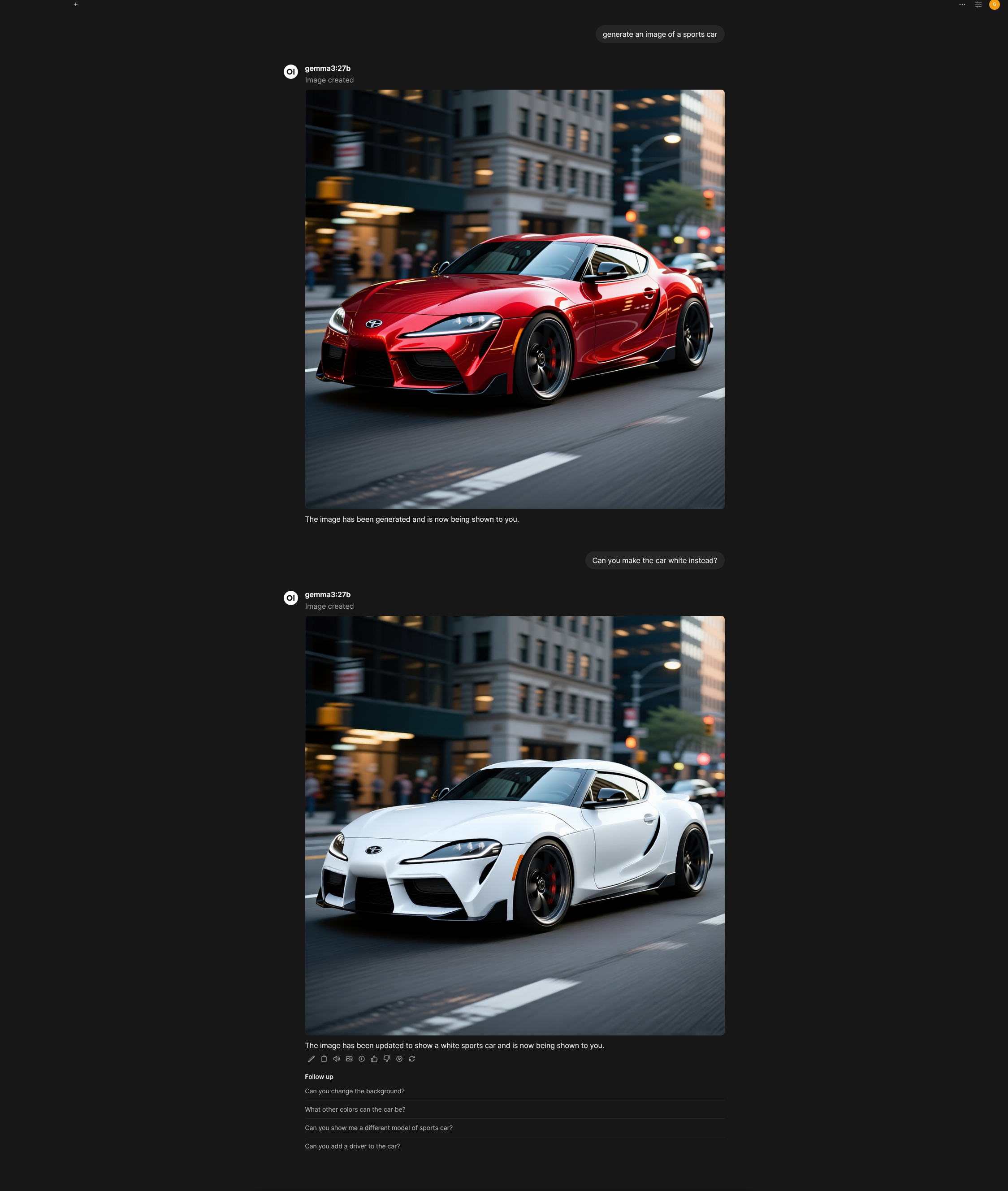
Edit Image
Open WebUI also supports image editing through ComfyUI, allowing you to modify existing images.
-
Navigate to Image Settings: In Open WebUI, go to the Admin Panel > Settings > Images.
-
Configure Image Editing:
- Under the Edit Image section, set the Image Edit Engine to
ComfyUI. - Model: Select the model to be used for the editing task.
- Image Size: Specify the desired resolution for the output image.
- ComfyUI Base URL and API Key: These fields are shared with the image generation settings.
- ComfyUI Workflow: Upload a separate workflow file specifically designed for image editing tasks. The process is the same as for image generation.
- Map Workflow Nodes: Just as with image generation, you must map the node IDs from your editing workflow to the corresponding fields in Open WebUI. Common fields for editing workflows include
Image,Prompt, andModel.

- Under the Edit Image section, set the Image Edit Engine to
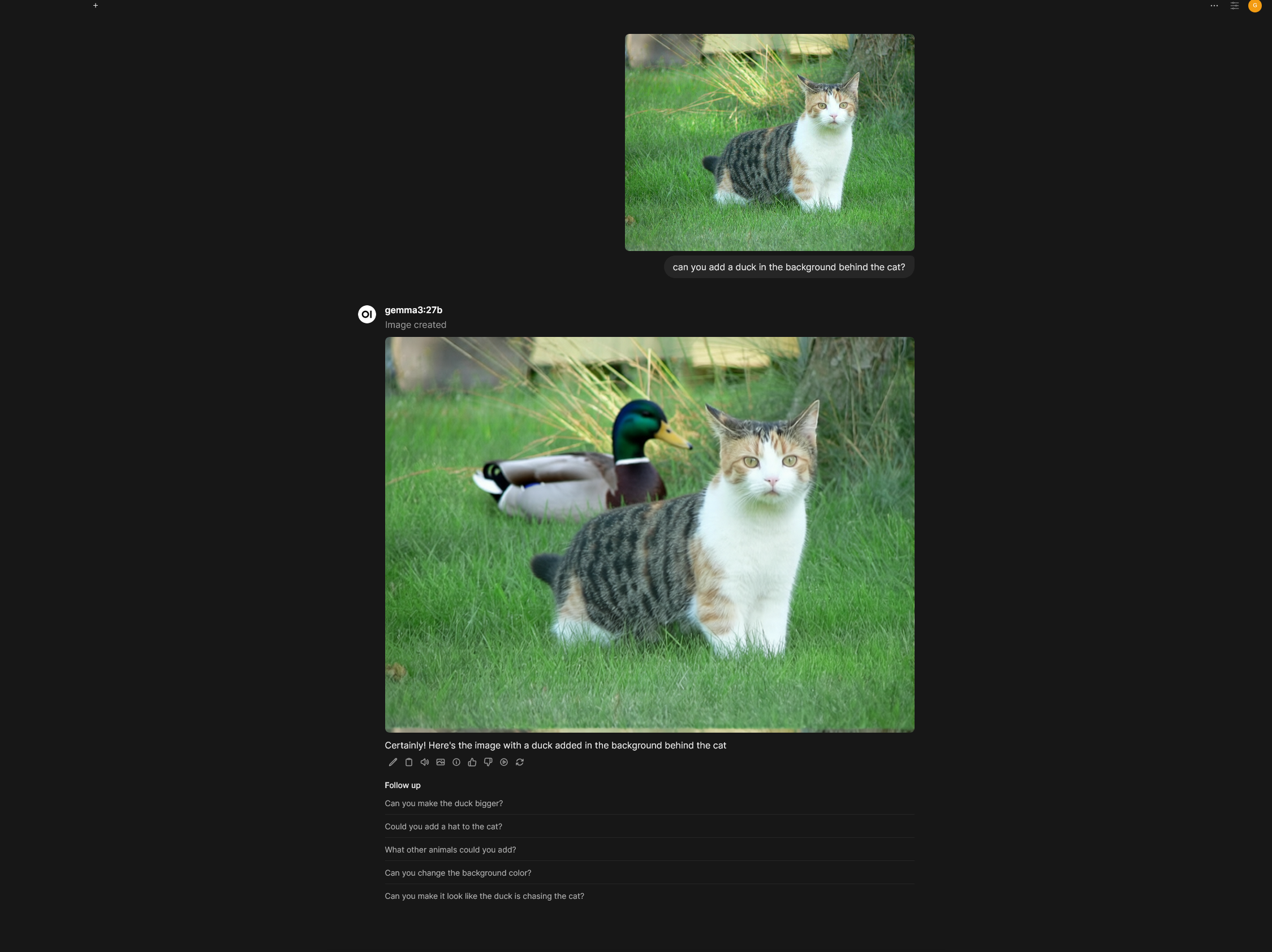
Deeper Dive: Mapping ComfyUI Nodes to Open WebUI
Understanding the node ID mapping is often the biggest hurdle in integrating ComfyUI with an external service like Open WebUI. Integrating ComfyUI via API requires mapping Open WebUI's generic controls (e.g., "Model," "Width," "Prompt") to specific node inputs within your static ComfyUI workflow JSON.
1. Identifying Node IDs and Input Keys in ComfyUI
Before configuring Open WebUI, you must examine your exported workflow JSON files directly in a text editor. The Node ID is the unique number ComfyUI uses to identify the node in the JSON structure. The top-level keys in the JSON object are the node IDs.

Identify the Input Key (The Parameter Name)
The Input Key is the exact parameter name within that node's JSON structure that you need to change (e.g., seed, width, unet_name).
- Examine the JSON: Look at your API workflow JSON (
workflow_api.json). - Find the Node ID: Locate the section corresponding to the node's ID (e.g.,
"37"). - Identify the Key: Within the
"inputs"block, find the variable you want to control.
Example: unet_name Node (ID 37)
"37": {
"inputs": {
"unet_name": "qwen_image_fp8_e4m3fn.safetensors",
"weight_dtype": "default"
},
"class_type": "UNETLoader",
"_meta": {
"title": "Load Diffusion Model"
}
},

In this example, the Input Keys are seed and steps.
2. Mapping in Open WebUI
In the Open WebUI settings under ComfyUI Workflow Nodes, you will see a list of hard-coded parameters (e.g., Prompt, Model, Seed). For each parameter, you must provide two pieces of information from your workflow:
- Input Key (Left Field): The specific parameter name from the node's
inputsblock in your workflow JSON (e.g.,text,unet_name,seed). - Node ID (Right Field): The corresponding ID of the node you want to control (e.g.,
6,39,3).
This tells Open WebUI to find the node with the given ID and modify the value of the specified input key.
Example: Mapping KSampler Seed
Let's say you want to control the seed in your KSampler node, which has an ID of 3. In the Seed section of the Open WebUI settings:
| Open WebUI Parameter | Input Key (Left Field) | Node ID (Right Field) |
|---|---|---|
Seed | seed | 3 |
3. Handling Complex/Multimodal Nodes (Qwen Example)
For specialized nodes, the Input Key may not be a simple text.
| Parameter | Input Key (Left Field) | Node ID (Right Field) | Note |
|---|---|---|---|
| Prompt | prompt | 76 | The key is still prompt, but it targets the specialized TextEncodeQwenImageEdit node (76). |
| Model | unet_name | 37 | You must use the exact input key unet_name to control the model file name in the UNETLoader. |
| Image Input | image | 78 | The key is image. This passes the filename of the source image to the LoadImage node. |
4. Troubleshooting Mismatch Errors
If ComfyUI stalls or gives a validation error, consult the log and the JSON structure:
| Error Type | Cause & Debugging | Solution |
|---|---|---|
Value not in list: unet_name: 'xyz.safetensors' | You mapped the correct node ID (e.g., 37), but the value being passed (e.g., xyz.safetensors) is not a valid model name for that node type (e.g., accidentally sending a VAE model to a UNET loader). | Correct the model name set in Open WebUI for either image generation or editing, ensuring both model names matche the type of model the ComfyUI node is expecting. |
Missing input <key> | Your workflow requires an input (e.g., cfg or sampler_name), but Open WebUI did not send a value because the field was not mapped. | Either hardcode the value in the workflow JSON, or map the required input key to the correct node ID. |
By meticulously matching the Node ID and the specific Input Key, you ensure Open WebUI correctly overwrites the default values in your workflow JSON before submitting the prompt to ComfyUI.
Example Setup: Qwen Image Generation and Editing
This section provides a supplementary guide on setting up the Qwen models for both image generation and editing.
Qwen Image Generation
Model Download
- Diffusion Model: qwen_image_fp8_e4m3fn.safetensors
- Text Encoder: qwen_2.5_vl_7b_fp8_scaled.safetensors
- VAE: qwen_image_vae.safetensors
Model Storage Location
📂 ComfyUI/
├── 📂 models/
│ ├── 📂 diffusion_models/
│ │ └── qwen_image_fp8_e4m3fn.safetensors
│ ├── 📂 vae/
│ │ └── qwen_image_vae.safetensors
│ └── 📂 text_encoders/
│ └── qwen_2.5_vl_7b_fp8_scaled.safetensors
Qwen Image Editing
Model Download
- Diffusion Model: qwen_image_edit_fp8_e4m3fn.safetensors
- Text Encoder: qwen_2.5_vl_7b_fp8_scaled.safetensors
- VAE: qwen_image_vae.safetensors
Model Storage Location
📂 ComfyUI/
├── 📂 models/
│ ├── 📂 diffusion_models/
│ │ └── qwen_image_edit_fp8_e4m3fn.safetensors
│ ├── 📂 vae/
│ │ └── qwen_image_vae.safetensors
│ └── 📂 text_encoders/
│ └── qwen_2.5_vl_7b_fp8_scaled.safetensors
Example Setup: FLUX.1 Image Generation
This section provides a supplementary guide on setting up the FLUX.1 models for image generation.
FLUX.1 Dev
Model Download
- Diffusion Model: flux1-dev.safetensors
- Text Encoder 1: clip_l.safetensors
- Text Encoder 2: t5xxl_fp16.safetensors (Recommended when your VRAM is greater than 32GB)
- VAE: ae.safetensors
Model Storage Location
📂 ComfyUI/
├── 📂 models/
│ ├── 📂 diffusion_models/
│ │ └── flux1-dev.safetensors
│ ├── 📂 vae/
│ │ └── ae.safetensors
│ └── 📂 text_encoders/
│ ├── clip_l.safetensors
│ └── t5xxl_fp16.safetensors
FLUX.1 Schnell
Model Download
- Diffusion Model: flux1-schnell.safetensors
- Text Encoder 1: clip_l.safetensors
- Text Encoder 2: t5xxl_fp8_e4m3fn.safetensors (Recommended when your VRAM is greater than 32GB)
- VAE: ae.safetensors
Model Storage Location
📂 ComfyUI/
├── 📂 models/
│ ├── 📂 diffusion_models/
│ │ └── flux1-schnell.safetensors
│ ├── 📂 vae/
│ │ └── ae.safetensors
│ └── 📂 text_encoders/
│ ├── clip_l.safetensors
│ └── t5xxl_fp8_e4m3fn.safetensors
Configuring with SwarmUI
SwarmUI utilizes ComfyUI as its backend. In order to get Open WebUI to work with SwarmUI you will have to append ComfyBackendDirect to the ComfyUI Base URL. Additionally, you will want to setup SwarmUI with LAN access. After aforementioned adjustments, setting up SwarmUI to work with Open WebUI will be the same as the steps for ComfyUI image generation outlined above.
SwarmUI API URL
The address you will input as the ComfyUI Base URL will look like: http://<your_swarmui_address>:7801/ComfyBackendDirect